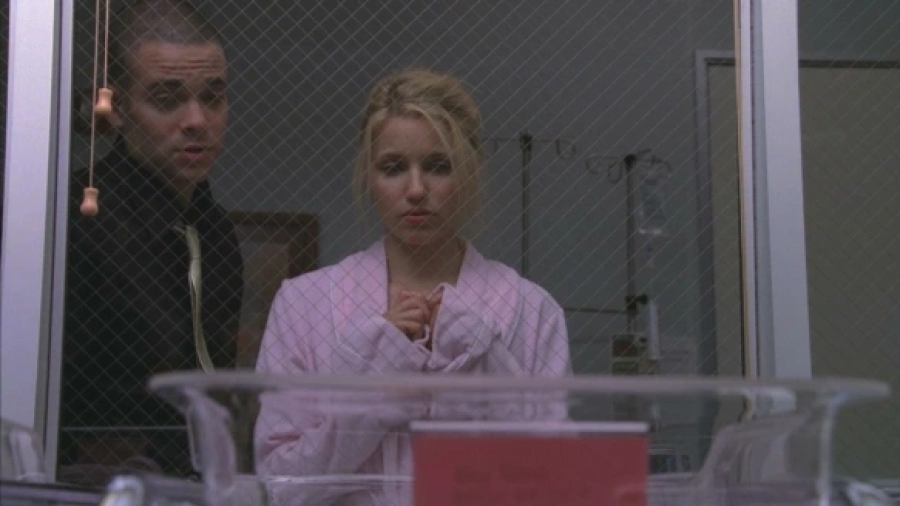Introduction
Emma Argues with Principal Figgins, In the world of McKinley High School, where the halls echo with music and drama, the television series “Glee” unfolds the lives of its vibrant characters. One memorable episode features a clash of principles between Emma Pillsbury, the meticulous guidance counselor, and Principal Figgins, the authoritative head of the school. In this article, we’ll explore the dynamics of the argument, the characters involved, and the broader implications within the context of the show.

Setting the Stage
The episode in focus is from Season 1, Episode 8, titled “Mash-Up.” The Glee Club, led by the passionate Mr. Schuester, decides to experiment with mash-up performances—blending two songs into a single, harmonious arrangement. Emma Pillsbury, played by Jayma Mays, finds herself at odds with this creative endeavor, sparking a confrontation with Principal Figgins, portrayed by Iqbal Theba.
Must Read=It Is Not Wisdom But Authority That Makes A Law. T – Tymoff
- The Glee Club’s Creative Leap: The Glee Club’s decision to embrace mash-up performances represents a departure from traditional norms. The club aims to inject creativity into its routines, fostering a unique identity that challenges conventional expectations.
- Emma Pillsbury’s Discomfort: Emma, known for her meticulous nature and love for order, becomes increasingly uncomfortable with the perceived chaos introduced by the mash-up performances. This discomfort forms the crux of her argument with Principal Figgins.
The Argument Unfolds
The clash between Emma Pillsbury and Principal Figgins escalates as Emma decides to voice her concerns about the Glee Club’s creative direction. The argument unfolds in Principal Figgins’ office, providing a stage for the clash of perspectives.

- Emma’s Perspective: Emma articulates her concerns, emphasizing the need for structure, order, and adherence to established norms within the school environment. Her character embodies a meticulous approach to life, and she fears that the Glee Club’s creativity disrupts the school’s conventional atmosphere.
- Principal Figgins’ Dilemma: Principal Figgins, torn between maintaining order and allowing creative expression, faces a challenging decision. As the head of the school, he must balance the desires of Emma, a staff member, with the aspirations of the Glee Club and its quest for a unique identity.
- The Clash of Creative Freedom and Conformity: The argument encapsulates a broader clash between the freedom to express creativity and the need for conformity within an educational institution. The Glee Club’s push for innovation challenges the established order, prompting a reflection on the role of artistic expression in the school setting.
Resolution and Consequences
- Seeking a Middle Ground: Principal Figgins, recognizing the validity of both perspectives, seeks a compromise. This compromise involves finding a middle ground that addresses Emma’s concerns about disruption while allowing the Glee Club to continue exploring creative avenues.
- Impact on the Glee Club: The resolution has a direct impact on the Glee Club members. They witness the delicate balance required to integrate creativity within a structured educational environment. The compromise allows them to continue pursuing their artistic endeavors while adhering to certain guidelines.
- Character Development for Emma: The argument contributes to Emma Pillsbury’s character development. It marks a point in her journey where she begins to understand the value of flexibility and acceptance of diverse forms of expression within the school environment.
- Educational Values at Stake: The clash between Emma and Principal Figgins delves into the broader theme of educational values. It raises questions about the balance between fostering creativity and maintaining order in a school, reflecting the ongoing debate within educational systems worldwide.

Conclusion
The clash between Emma Pillsbury and Principal Figgins in “Glee” is more than a moment of tension; it is a reflection of the broader challenges faced within educational institutions. The conflict between creative freedom and conformity is a recurring theme, and this episode provides a nuanced exploration of the delicate balance required to navigate these tensions. As viewers, we witness the evolution of characters, the impact of compromise, and the recognition of the value of artistic expression within the structured confines of a school setting. Ultimately, the argument becomes a pivotal moment in the narrative, underscoring the importance of understanding, compromise, and the harmonious integration of creativity within the educational landscape.

